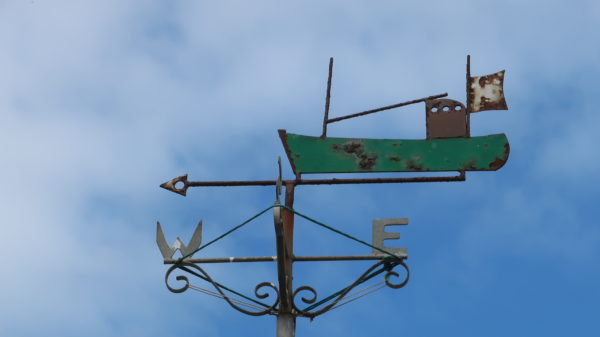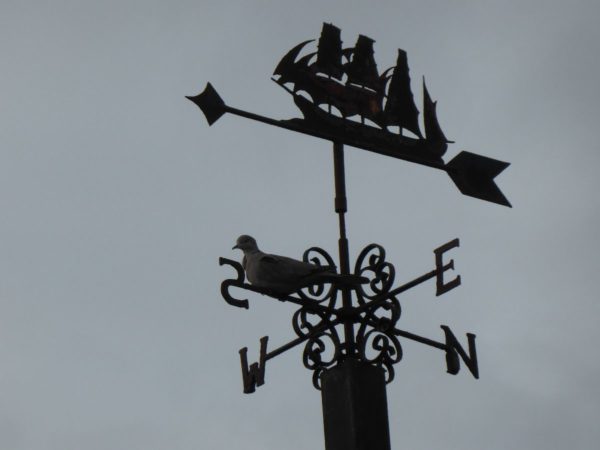
This month we’re having a look at how directions and points of the compass were traditionally used in the Gaelic Highlands, and therefore in Gaelic-influenced Seaboard English, which also carried over into behaviour patterns still familiar to some people today.
If you look at the map, it’s clear that the Seaboard coast runs roughly north-east to south-west, but I’ve never heard anyone refer to the ends of the Villages except as east and west. In Hilton you went, and still go, east to the burn or the chapel, not north-east. So-and-so’s house, on the same NE-SW street, might be “a bit west” of someone else’s. This might seem just shorthand for the more exact orientation, but there’s more to it than that.
Nowadays we’re used to seeing, and giving, directions in terms of the usual map view – north is up, south is down. For distant places this was to a large extent also true traditionally, in Gaelic or English – you’d sail up to Orkney, or people went down to Glasgow or London to work. At a more local level, however, this was very different. Maps were not what people used, or even possessed, until relatively recently, so a map’s view of up and down was irrelevant. What mattered, and what people who lived from it were intimately familiar with, was the lie of the land. The main point of reference was direction of water flow. Up (Gaelic suas, pronounced /soo-as/) was upstream, and down (sìos, pron. /shee-as/) was downstream. So up could be north, south, east or west, depending on geography. This meant that there was nothing odd in a north-facing community in telling someone to go suas gu deas – up south (southwards upstream) to a place. Roughly south or south-east-facing communities, like Easter Ross, had coincidentally upstream to their north or north-east, so they could say suas gu tuath – up north, for local directions, coinciding more or less with the map view. There are examples all over the Highlands and Islands of place-names echoing the changing geography.
This Gaelic-influenced feature has even been continued over in Nova Scotia. Cape Breton natives are famous for saying “Down North” – there possibly related to wind and therefore sailing direction (upwind and downwind in relation to their prevailing winds). They also say they’re going up and down to places which are east and west. In Easter Ross we can do the same.
While it’s logical for us to say “I’m going up to Fearn” (up the hill) we also still say things like “I’m going up to Dingwall / Inverness”, even though they’re not to the north or uphill – but they’re “up the firth”, i.e. upstream from here. Travel was largely by water until relatively recently in our history, as roads were poor and people didn’t have vehicles, so sea and rivers were dominant in people’s lives. It was also common in the East Highlands to refer to a westerly / easterly wind as gaoth à shuas / à shìos – a wind from upstream / downstream, as the mountains were west of the coast.
So far, so good. That meant in our area that if you had your back to the hill (where upstream was, roughly north), and were facing the sea (roughly south), the natural orientation of fishing villages, then on your left you had east, and on your right you had west. Thus east and west came to be used for left and right when speaking English. And that’s why older folk like my granny always talked about going east to the kitchen, or west to the (good) room. East – west was the most important orientation for communication and daily movement in the Villages, so these terms, rooted in the landscape-based Gaelic language, were absolutely normal. It was also, significantly, the path of the sun, visible in its arc over the sea every day.
The sun itself was another natural element that was reflected in Gaelic words for directions. As in probably all cultures, the sun was seen as life-giving, its light eagerly awaited and its progress determining daily and seasonal activities. The most propitious way to face in the morning was eastwards, and you’d turn to follow the sun southwards and westwards throughout the day. West to north to east again was the night, the dark and dangerous time and therefore direction. South came to mean good luck and prosperity, north bad luck. This is what has led to all the folklore and superstition that calls for doing things “sunwise”, or clockwise. The opposite, called “widdershins” in Scots (which literally means “against the sun”), was really unlucky. Seaboard fishing boats (despite being full of good Presbyterian seamen) always turned sunwise – taking no chances! Superstition was rife among the fishermen despite their sincere religious beliefs – I think of it as a belt and braces approach. They also always said “12 plus one” when counting, instead of 13, hence the numbering of this article!
The word for south in Gaelic is deas (pron. /jess/), and this is also the word for right, as in right-handed. South would be on your right-hand side when facing the rising sun in the east, the starting point for the “good” hours of the daytime. Again, many cultures consider right good, left bad. On the Seaboard it was considered bad luck to have the spouts of jugs and teapots facing left on the shelf. From deas Gaelic has the word deiseil (/jesh-al/), which means sunwise, moving in the same direction as the sun. It also means ready, prepared, based on the idea that you’re set on the right course. Katy Ross told me that to was customary for the fisherman who lived furthest from the boat to go round in the morning making sure the others en route were up and about by calling at their window “Am beil thu deiseil?” – a much more loaded and promising word than the English “ready”. She heard it called to her father every morning.
So when you next hear what seems to be an odd use of up and down, or east and west, or left and right, just remember there will have been a perfectly logical reason for it in the Gaelic it came from. Enjoy them, and treasure them!
And as usual, let me have any more examples you hear or remember yourselves!
